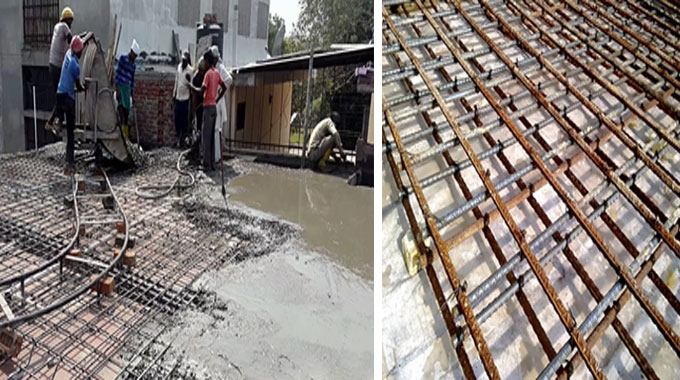
Roof Slab Design Process
The design of a roof slab is based on the thickness of slab, size of bars, distances of bars, hooks, cranks and laps of bars, minimum cover of concrete etc. The concrete mix for the slab is normally provided with volume and it?s ratio is 1:2:4 ( cement, sand and aggregate).
Because of severe loading, the slab is prone to potential or sagging bonding movement on the bottom surface at the centre of the span and negative or hogging bending moment at top near supports. To counter these moments main reinforcement is arranged at bottom surface along the direction of span to get rid of positive bending moment.
Based on the span, an RCC slab should be designed as either one way reinforced slab or two way reinforced slab. In one way slab, beams provide support to the slabs on the two opposite sides. When the ratio among the length and width of the room over which the slab will be arranged remains in excess of 2, one way slab is suitable. One way slab comprises of main reinforcement distancing among the supports with dispersion of reinforcement at right angles to it. Two way slab stretches in two directions, when the length to breadth ratio remains under 2. Under such situation, main reinforcement is arranged in both directions in the form of a mesh.
The complete thickness of slab normally remains 10 cm though the minimum thickness increases up to 7.5 cm. The minimum area of reinforcement per unit width of a slab shall not remain under 0.15% concerning the gross cross sectional area of concrete. But because of other constraints, it is essential to arrange greater percentage of steel in the slab.
Spacing of bars of main reinforcement should not go beyond 3 times the effective depth of slab and spacing for the distribution bars should not remain in excess of five times the effective depth. Spacing in excess of 20 cm diameter for main bars and not in excess of 40 cm for distribution bars should be arranged.
Bars not more than 6 mm diameter or surpassing 18 mm should not be recommended for slabs. 10 mm or 12 mm plain M.S. bars or 8 mm or 10 mm tor-steel bars are normally utilized. They are arranged at the bottom of the slab with minimum cover of 25 mm of concrete.
Besides, the bars arranged at the bottom along the main direction, bars along the longer extent are also provided on top of the main bars and at right angles to them. These are known as ? distribution? bars or ?temperature reinforcement? or ? transverse bars?. The purpose of the distribution bars is to control cracks caused by deviation of temperature and shrinkage stresses. They also help in dispersing loads. The area of such reinforcement normally remains 20 % of that of main reinforcement. Plain M.S. bars with 6 mm diameter are normally utilized for this purpose.
In all buildings, slabs cover the full width of the wall over which walls are uplifted. It produces partially fixed conditions for the slab. Under such condition, every alternate bar should be bent up. This arrangement is inexpensive in respect of arranging extra bars at the top. The main bottom bar is cranked at one-fifth of the span at either end and taken up.
Main and distribution bars are attached together through black mild steel wire containing 16 guage by affording a cross and twisting the ends. If wire with lower diameter is applied, double strands of wire should be arranged rather than single strand. To bind 1 tonne of reinforcing bars, around 5 kg. of binding wire is necessary.
As for example, consider a 2.5 M or 8?0? wide verandah where the thickness of slab should be 10 cm. Main bars should be 10 mm plain M.S. or 8 mm tor-steel and arranged at 20 cm centre at bottom of the slab along the short span with a cover of 25 mm. Each alternate bar is cranked up to 0.5 M from the edge of wall and at both ends 6 mm plain M.S. bars should be arranged as distribution bars and are provided at 30 cm centres at the top of the bottom bars. For the cranked bars adjacent to the supports at the top of the slab distribution bars with similar size and spacing are arranged under the top bars.


